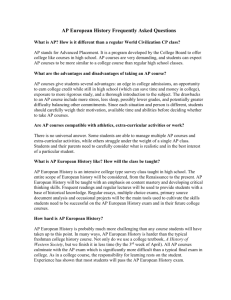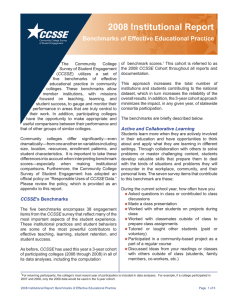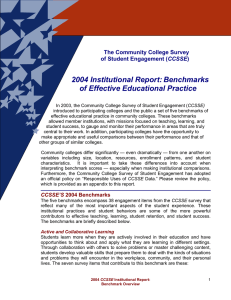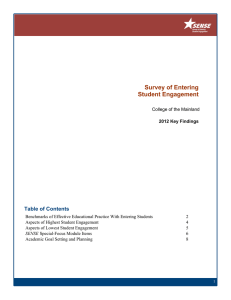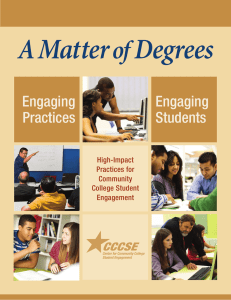CCSSE Benchmarks Results on Student Success 2005 vs. 2008 vs. 2012
advertisement
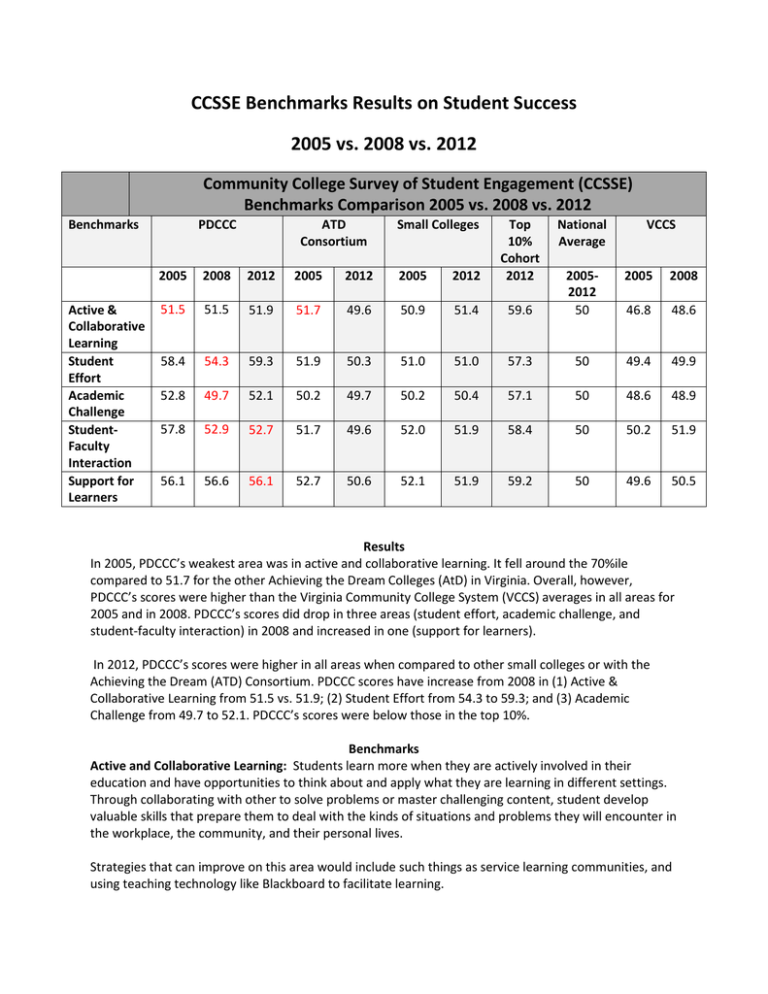
CCSSE Benchmarks Results on Student Success 2005 vs. 2008 vs. 2012 Community College Survey of Student Engagement (CCSSE) Benchmarks Comparison 2005 vs. 2008 vs. 2012 Benchmarks Active & Collaborative Learning Student Effort Academic Challenge StudentFaculty Interaction Support for Learners PDCCC ATD Consortium Small Colleges 2005 2008 2012 2005 2012 2005 2012 Top 10% Cohort 2012 51.5 51.5 51.9 51.7 49.6 50.9 51.4 58.4 54.3 59.3 51.9 50.3 51.0 52.8 49.7 52.1 50.2 49.7 57.8 52.9 52.7 51.7 56.1 56.6 56.1 52.7 National Average VCCS 2005 2008 59.6 20052012 50 46.8 48.6 51.0 57.3 50 49.4 49.9 50.2 50.4 57.1 50 48.6 48.9 49.6 52.0 51.9 58.4 50 50.2 51.9 50.6 52.1 51.9 59.2 50 49.6 50.5 Results In 2005, PDCCC’s weakest area was in active and collaborative learning. It fell around the 70%ile compared to 51.7 for the other Achieving the Dream Colleges (AtD) in Virginia. Overall, however, PDCCC’s scores were higher than the Virginia Community College System (VCCS) averages in all areas for 2005 and in 2008. PDCCC’s scores did drop in three areas (student effort, academic challenge, and student-faculty interaction) in 2008 and increased in one (support for learners). In 2012, PDCCC’s scores were higher in all areas when compared to other small colleges or with the Achieving the Dream (ATD) Consortium. PDCCC scores have increase from 2008 in (1) Active & Collaborative Learning from 51.5 vs. 51.9; (2) Student Effort from 54.3 to 59.3; and (3) Academic Challenge from 49.7 to 52.1. PDCCC’s scores were below those in the top 10%. Benchmarks Active and Collaborative Learning: Students learn more when they are actively involved in their education and have opportunities to think about and apply what they are learning in different settings. Through collaborating with other to solve problems or master challenging content, student develop valuable skills that prepare them to deal with the kinds of situations and problems they will encounter in the workplace, the community, and their personal lives. Strategies that can improve on this area would include such things as service learning communities, and using teaching technology like Blackboard to facilitate learning. Student Effort: Students’ own behaviors contribute significantly to their learning and the likelihood that they will successfully attain their educational goals. “Time on task” is a key variable, and there are a variety of settings and means through which students may apply themselves to the learning process. Academic Challenge: Challenging intellectual and creative work is central to student learning and collegiate quality. Ten items from the Community College Student Report correspond to components of academic challenge including the nature and amount of assigned academic work, the complexity of cognitive tasks presented to students, and the standards faculty members use to evaluate student performance. Student-Faculty Interaction: The more contact students have with their teachers, the more likely they are to learn effectively and to persist toward achievement of their educational goals. Personal interaction with faculty members strengthens students’ connections to the college and helps them focus on their academic progress. Working with an instructor on a project or serving with faculty members on a college committee lets students see firsthand how experts identify and solve practical problems. Through such interactions, faculty members become role models, mentors, and guides for continuous, lifelong learning. Support for Learners: Students perform better and are more satisfied at colleges that are committed to their success and cultivate positive working and social relationships among different groups on campus. Community college students also benefit from services targeted to assist them with academic and career planning, academic skill development, and other issues that may affect both learning and retention.

